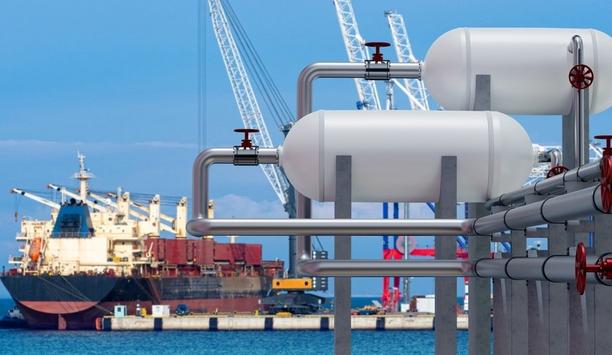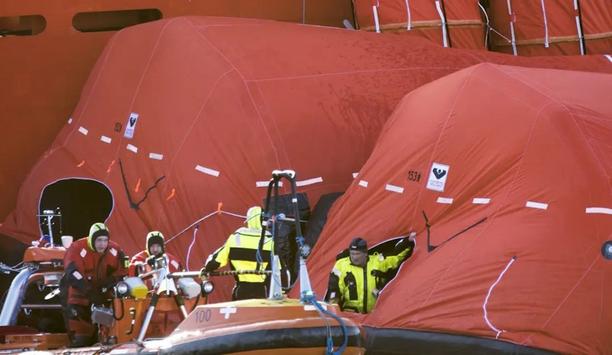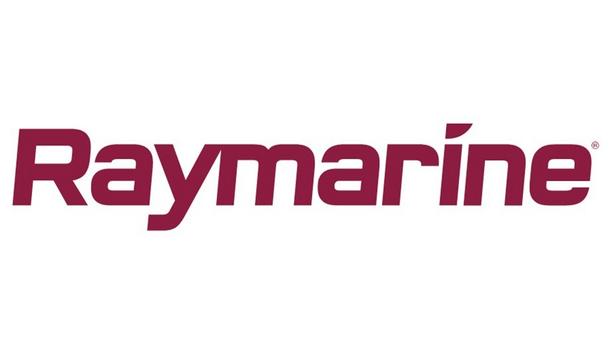The Port of València is already the first port in the world to use a ReachStacker or stacker capable of moving containers of more than 30 tonnes using hydrogen as the only fuel.
The European H2PORTS project, led by the Fundación Valenciaport, has organised this morning a public demonstration of the three pilots developed within the framework of this project, the ReachStacker (container stacker) and the 4×4 tractor unit propelled by hydrogen and the mobile supply station for this clean fuel.
Opening of the conference
The demonstration event took place first in the auditorium of the Port Authority of Valencia (PAV), and then at the MSCTV terminal and Valencia Terminal Europa (VALTE), the terminal of the Grimaldi Group, where the participants were able to see the machines in operation.
The opening of the conference was attended by Francesc Sánchez, director of the PAV; Antonio Torregrosa, general director of the Fundación Valenciaport; Federico Torres, director of Ecological Transition of the PAV; Mirela Atanasiu, executive director of the Clean Hydrogen Partnership (the project’s funding entity); and Josep Sanz, director of Energy Transition and Sustainability of the Fundación Valenciaport and coordinator of the H2PORTS project.
Hydrogen ReachStacker
The hydrogen ReachStacker on display is an innovative zero-emission solution that uses a fuel cell
During the event, the public was able to see live the performance of the prototype hydrogen fuel cell ReachStacker developed by Hyster which was demonstrated in real operation at the MSCTV container terminal.
The hydrogen ReachStacker on display is an innovative zero-emission solution that uses a fuel cell from the manufacturer Nuvera to convert hydrogen into electricity.
Hydrogen fuel cell technologies
The machine arrived at the MSC terminal for testing in September 2023, becoming the first ReachStacker-type machine in Europe to use hydrogen fuel cell technologies for port handling equipment in real operating conditions.
Hydrogen is stored on board the ReachStacker in high-pressure tanks that can be refilled in 10-15 minutes.
Reduced operating costs
The hydrogen fuel cell supplies power to the electric motors or returns it to the batteries depending on the demand of the task while reducing greenhouse gas emissions and noise pollution compared to a diesel alternative and with similar performance.
In addition, eliminating the diesel engine, transmission and other mechanical drive components from the ReachStacker can help ports reduce operating costs.
First hydrogen-powered terminal tractor
The test was observed by the more than 150 people attending the demonstration
The attendees also traveled to the VALTE terminal where they were able to see in detail the world’s first hydrogen-powered terminal tractor, which was developed by ATENA with the support of ENEA and the Parthenope University of Naples.
The terminal tractor loaded with renewable hydrogen demonstrated its autonomy, reliability, and power by hitching up a truck trailer and driving around the terminal. The test was observed by the more than 150 people attending the demonstration, who saw how the only residue of the hydrogen combustion was water droplets.
Terminal Tractor
This Terminal Tractor has a fuel cell/battery hybrid powertrain which allows the vehicle to perform all the intensive tasks that are required during roll-on/roll-off operations.
Its hydrogen storage system, made of four Type 3 cylinders (350 bar), has an overall capacity of around 12 kg, which guarantees a continuous operation of at least 6 hours before refueling, corresponding to the average duration of a working shift.
Light and efficient device
The electric motor is a light and efficient device, particularly suitable for power-demanding applications. It is fed by a high-performance LiFePO4 battery, with 25 kWh energy capacity, and a 70 kW Ballard fuel cell module.
In particular, the electric motor can receive power for traction from the fuel cell and battery simultaneously or charge the battery during braking or decelerations. At the same time, the fuel cell can provide power both to the electric motor and the battery, if needed. The hybrid powertrain shows high operational efficiency, since it takes advantage of a significant share of kinetic energy recovery, up to 25.
Hydrogen supply and refueling
This supply station consists of a fixed part, located on the Xità quay, and a mobile part, which is used for refueling
In addition, the participants visited the hydrogen station, developed by the Spanish National Hydrogen Centre (CNH2), and learned about the details of the hydrogen supply and refueling management carried out by the company Carburos Metálicos.
This supply station consists of a fixed part, located on the Xità quay, and a mobile part, which is used for refueling.
Hydrogen compressed
CNH2 and Carburos Metálicos experts explained to the attendees how they carried out the hydrogen refueling operation of the ReachStacker, during which it was necessary that the mobile part of the hydrogen generator, which stores hydrogen compressed at 300 and 450 bar and includes a dispenser, be moved to the MSCTV terminal.
In this first test period, the operation tests of refueling approximately 30 kg of hydrogen from the ReachStacker were successfully carried out, performing the optimisation tasks by the refueling protocols, and complying with the limits and procedures established in the applicable regulations.
H2 to electricity
The pilot tests, which began in mid-September, are scheduled to run until December 2024, subjecting the machines to real operating conditions in a port terminal. Hydrogen is a clean energy carrier with the benefits of easy storage and when used produces no emissions other than heat and water.
The hydrogen fuel cell converts H2 to electricity resulting in a zero-emission equipment that, if combined with the use of renewable hydrogen, is also carbon neutral. The technology shows some advantages compared to other available zero-emission technologies like pure electric versions. This hydrogen version also shows a good operating range, short fuelling time, and low maintenance costs.
Reduce the environmental impact of its operations
This project reaffirms Valenciaport’s commitment to decarbonisation and the use of alternative energies
For Francesc Sánchez, director of the PAV, “this project reaffirms Valenciaport’s commitment to decarbonisation and the use of alternative energies to fossil fuels."
"This project that we are presenting today is a pioneer in Europe, a success for the Valenciaport Foundation, the València Port Authority, the European Commission, and all the companies and institutions that collaborate in the H2PORTS project.”
Efficient in alternative energies
“In the future, the most competitive ports will be the most efficient in alternative energies. At Valenciaport we are committed to all the options that head to decarbonisation, and this project that we are presenting today is probably the first in the world to use hydrogen in port terminal machinery operations,” he added.
For his part, Federico Torres, head of Energy Transition at Valenciaport, explained the diversity of projects that the PAV is working on to supply itself 100% with alternative energies: electrical substations so that ships can connect to the electricity grid, photovoltaic, hydrogen, wave, and wind power.
Sustainability, digitalisation, and efficiency
For Antonio Torregrosa, general director of Fundación Valenciaport, “One of the elements of competitiveness of this port has been innovation. That is why, for some time now, we have been trying out all kinds of technologies that have made this port a world benchmark in sustainability, digitalisation, and efficiency.”
Finally, Mirela Atanasiu, Executive Director and Interim – Clean Hydrogen Partnership acknowledged “the efforts of all the technicians, companies and consortiums that have collaborated in this pioneering project, which serves as an example for all the ports in the world”.
H2PORTS
Port of Valencia is the first port in Europe to incorporate hydrogen technologies to reduce the environmental impact
The European project “H2PORTS – Implementing Fuel Cells and Hydrogen Technologies in Ports” coordinated by Fundación Valenciaport, in close collaboration with the Port Authority of Valencia, and financed by the Clean Hydrogen Partnership programme, has as its main objective to test and validate hydrogen technologies on port machinery that allow for applicable and real solutions without affecting the performance and safety of port operations and producing zero local emissions.
The H2Ports project entails a total investment of 4 million euros and involves, in addition to Fundación Valenciaport and the Port Authority of Valencia, the National Hydrogen Centre, and the private companies MSC Terminal Valencia, Grimaldi Group, Hyster-Yale, ATENA Distretto Alta Tecnologia Energia Ambiente, Ballard Power Systems Europe, Carburos Metálicos (Air Products group) and Enagás. Due to this initiative, the Port of Valencia is the first port in Europe to incorporate hydrogen technologies to reduce the environmental impact of its operations.
About the Clean Hydrogen Partnership
The Clean Hydrogen Partnership, the successor of the Fuel Cells and Hydrogen Joint Undertaking (FCH JU) aims to strengthen and integrate European Union research and innovation capacity to accelerate the development and improvement of advanced clean hydrogen applications ready for market, across energy, transport, building, and industrial end-uses, while strengthening competitiveness of the Union clean hydrogen value chain.
The three members of the partnership are the European Commission, fuel cell and hydrogen industries represented by Hydrogen Europe, and the research community represented by Hydrogen Europe Research.












